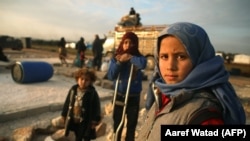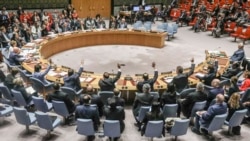On January 24, Chinese Ministry of Foreign Affairs spokesperson Zhao Lijian tweeted photographs of children picking up bullet casings and mortar shells in rubble, saying “[a]fter 20 years’ war, this is what the US has brought to the children in Afghanistan.”
Those photos, in fact, were of children in Idlib, northwest Syria, according to the photographer who took them.
“A Chinese Foreign Ministry spokesman has published photos taken by me in Idlib and claims that 'this is what the United States brought to the children in Afghanistan', but in fact, this is what the Syrian regime and Russian forces brought to the children in Idlib,” said Ali Haj Suleiman on January 27, tweeting a screenshot of Zhao’s post.
Suleiman’s photo series, “Shells of War,” was awarded an honorable mention in the UNICEF Photo of the Year Awards in December 2021. The series documents Syrian children collecting scrap metal for sale in Idlib, the last rebel-held province in the war-torn country.
Zhao deleted his tweet after Suleiman called him out. However, the images Zhao posted had been retweeted among his 1.1 million followers on Twitter and widely shared on China’s Twitter-like Weibo. China’s Assistant Minister of Foreign Affairs Hua Chunying, who is Zhao’s fellow spokesperson for the ministry, posted the same tweet and later deleted it.
Suleiman told Radio Free Asia (RFA), the Voice of America’s (VOA) sister organization, that the Chinese officials neither issued a correction for the misrepresentation nor apologized for using his photos without permission.
“I’m so angry because what the officials are doing is changing the truth,” Suleiman said in a written statement to RFA. “It’s so annoying when you see officials in countries trying to change the facts.”
This is not the first time officials from China’s Ministry of Foreign Affairs misused pictures to criticize the West’s military involvement in Afghanistan.
Last November, Zhao posted on Twitter a graphic, computer-generated illustration depicting a grinning Australian soldier holding a bloodied knife to the throat of an Afghan child. The tweet was in reference to an Australian inquiry into alleged war crimes by its soldiers in Afghanistan.
Australian lawmakers and Prime Minister Scott Morrison demanded China delete the image and formally apologize. Neither demand was met. Twitter also refused Morrison’s request to remove the doctored photo.
Suleiman’s photos reflected the dire consequences of the Syrian civil war, which has dragged out for more than a decade.
The United Nations identified 350,209 civilian casualties from the war between March 2011, when the conflict erupted, and March 2021. The U.N. said the tally indicated “a minimum verifiable number and is certainly an undercount of the actual number of killings.”
The U.K.-based Syrian Observatory for Human Rights estimated in June 2021 that the conflict had claimed 494,438 lives since 2011, Agence France-Presse reported.
The war created the world’s biggest refugee crisis, with the U.N. refugee agency estimating the number of Syrian refugees and asylum seekers at 6.8 million.
What began in 2011 as popular and peaceful protests against President Bashar al-Assad’s regime, calling for reform and an end to its corruption, quickly escalated into a brutal civil and proxy war between Assad’s government, backed by Russia, Iran and Hezbollah, and anti-government rebel groups, backed by the United States, Turkey, Saudi Arabia and Kurds.
Syrian civilians, many of them women and children, have been victims of brutality. While all parties to the conflict, the U.S.-led coalition included, have been accused of human rights violations and war crimes, the Assad regime has by far perpetrated most of the violence against civilians, The New York Times reported.
The Assad regime has been accused of repeatedly using chemical weapons, including the Ghouta chemical attack in 2013, the 2017 chemical attack in Khan Shaykhun, a town in southern rebel-held Idlib province, and the Douma chemical attack in 2018.
Syrian government forces have also used conventional weapons, aerial bombardment, siege, starvation and expulsion against civilians.
“The Chinese government is participating in the ongoing massacre against the Syrian people through its use of its veto in the Security Council against decisions aimed at deterring the Syrian regime from killing the people and even against decisions to pass humanitarian aid to Syrians across the border,” Suleiman told RFA.
China, however, has kept a relatively low profile compared to the main parties directly involved in military action. China has used its veto power in the U.N. Security Council numerous times in alignment with Russia to side with the Assad regime.
One example: China and Russia vetoed twice in a week resolutions by Western Security Council members to extend the delivery of humanitarian aid from Turkey across border crossings into Idlib and Aleppo provinces, Reuters reported in July 2020. The remaining Security Council members all voted in favor of the resolutions.
The United Nations said humanitarian aid delivered from Turkey was a “lifeline” for millions of Syrian civilians in the country’s northwest.
China has provided humanitarian aid to Syria through bilateral and multilateral channels. It has also participated in conflict mediation efforts on Syria by attending peace talks like the Geneva I and Geneva II peace conferences, the Vienna peace talks, and by welcoming the Astana Peace Process initiated by Russia, Iran and Turkey.
In vetoing multiple U.N. resolutions on Syria, China claimed it based those decisions on its longstanding declared policy of respecting state sovereignty and not interfering in the internal affairs of other nations.
China’s Syria policy has been driven mainly by its security and economic objectives in the region, according to Giorgio Cafiero, CEO and founder of Gulf State Analytics, a geopolitical risk consultancy based in Washington, D.C.
“Beijing wants to build a strong partnership with Damascus to maintain friendly ties and cooperate on counter-terrorism issues,” Cafiero wrote. “Second, economically, the Chinese leadership seeks a Sino-Syrian relationship that helps Beijing advance its vision for the ambitious Belt and Road Initiative (BRI).”
The BRI is China’s plan to build a network of infrastructure projects across Asia and Africa, fostering economic ties and enhancing its trade prospects.



